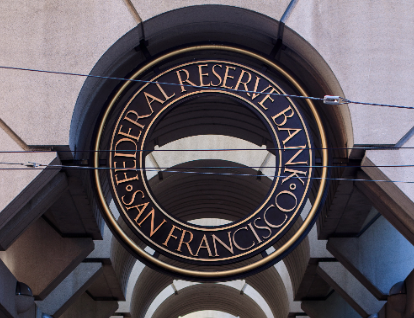 Over the past year, the usually murky foreign exchange ('FX') market had one clear trade...
Over the past year, the usually murky foreign exchange ('FX') market had one clear trade...
In this corner of investing, traders skilled at guessing broad economic trends look to trade sovereign nations' currencies against each other.
Similar to the commodities markets, the FX market is often made up of big institutions on one side looking to hedge risk, while speculators on the other side are on the hunt for profit.
The most famous example of a big win in the FX market is when legendary investor George Soros "broke" the Bank of England in 1992. When the highly inflationary British pound was pegged to the German mark, Soros recognized the unsustainability of this arrangement and began to aggressively short the pound.
When the U.K. was unable to maintain the relationship of the pound to the mark and left the European exchange rate agreement, traders were able to make a killing. Soros himself made more than $1 billion from his position.
With the pandemic creating unique currency flow trends, traders have been hoping for an opportunity to follow in Soros' footsteps.
In this vein, financial-services giant Goldman Sachs (GS) recommended shorting the U.S. dollar back in October – expecting it to have a similar bout of volatility.
Goldman's currency team sold the dollar against a basket of 10 commodity currencies. Following other currency trades, the company sought to take advantage of a perceived economic weakness.
 But it was unable to replicate Soros' big success in the early '90s...
But it was unable to replicate Soros' big success in the early '90s...
After a fruitless six months, Goldman is beating a hasty retreat on its bearish position on the greenback.
The thought was that the dollar has historically been a safe currency, anchored by sound monetary policy and America's hyperpower status. However, six months ago, with rounds of large stimulus bills and the world economy accelerating, it was believed that people would no longer need to flee to the safety of the dollar... and thus the greenback would underperform.
This thesis never came to pass. The Bloomberg Dollar Spot Index has risen by more than 2% this year, and longer-dated U.S. Treasury yields have surged. Here at Altimetry Daily Authority, we covered this recent bounce and the drivers behind it back in March.
The big reason for the rally is that over the past few months, world's recovery has split in two.
Thanks to large government spending and investment into vaccine distribution, the U.S. is poised for a strong recovery in 2021. Recent job reports and the healthy Treasury rate changes all point to an economic boom.
Meanwhile, as we highlighted last Wednesday, other parts of the world – particularly developing countries – are seeing a much slower recovery process as they struggle to fight the coronavirus.
Many parts of Europe are seeing a much more stop-and-go recovery and are falling behind the U.S.
The U.S. – especially the U.S. consumer – is likely to once again take the lead in global growth for the short term. Stronger economic growth and higher interest rates mean a stronger dollar.
 The potential for stronger growth in the U.S. sets in motion a slew of economic consequences...
The potential for stronger growth in the U.S. sets in motion a slew of economic consequences...
Last Monday, we explained how the economy reopening may cause inflation to spike in the short term. With more money chasing the same or even fewer goods, prices could rise.
However, we also discussed how the odds of long, protracted inflation are slim. Remember, periods of high inflation are anomalies, not the norm.
And after the "stagflation" of the 1970s, the U.S. Federal Reserve is now mindful of effectively controlling inflation. By adjusting the federal funds rate in response to the economy heating up, the Fed is able to control lending and reel in inflationary activity.
With the rise of the dollar and the expectation that the U.S. economy could be on the cusp of a boom, the odds are steadily climbing that the Fed will start raising rates to fight inflation before it becomes a problem.
Financial-services firm CME Group (CME) tracks the probability that the Fed will raise rates during its meetings. Back in February, it listed no chance of this until at least September.
However, over the past two months, the picture has started to change...
Now, there's a 5% chance the Fed could raise rates come June... and almost a 20% chance it could raise them by the end of the year.
 The U.S. isn't out of the woods of the pandemic yet, so the odds still clearly tilt to interest rates remaining at rock-bottom levels...
The U.S. isn't out of the woods of the pandemic yet, so the odds still clearly tilt to interest rates remaining at rock-bottom levels...
However, monitoring what the Fed is planning to do helps with understanding future growth and Treasury yields.
This metric is trending in the direction of interest rates rising sooner than many folks expected.
But no matter what the financial media tells you about sounding the alarm, this is actually bullish for the economy.
When the Fed raises rates, it expects strong economic growth... which leads directly to corporate earnings growth.
While uncontrolled rate hikes can constrict economic growth, the Fed starting to raise rates is an exceptionally bullish signal. And with such a low rate today, any rate hikes in 2021 won't stop a recovery... and they show that the U.S. economy is accelerating much faster than anyone expected.
Regards,
Joel Litman
April 19, 2021



 Over the past year, the usually murky foreign exchange ('FX') market had one clear trade...
Over the past year, the usually murky foreign exchange ('FX') market had one clear trade...

